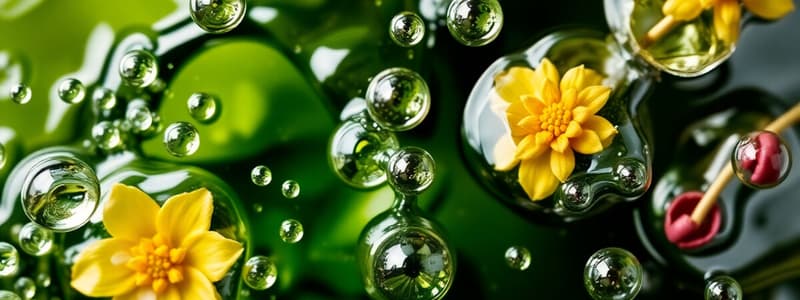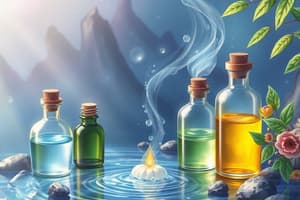Podcast
Questions and Answers
What is the main reason why clarification is not needed for chloroform water?
What is the main reason why clarification is not needed for chloroform water?
- Chloroform has no flavor.
- Chloroform is soluble in water.
- Chloroform must remain in the bottle due to its density. (correct)
- Chloroform evaporates quickly.
Which component of peppermint oil is primarily removed during the clarification process?
Which component of peppermint oil is primarily removed during the clarification process?
- Ketones
- Alcohols
- Terpenes (correct)
- Aldehydes
What is the purpose of preparing concentrated aromatic waters?
What is the purpose of preparing concentrated aromatic waters?
- To simplify the clarification process. (correct)
- To stabilize the aromatic waters.
- To enhance the aroma without dilution.
- To eliminate the need for alcohol.
What affects the stability of aromatic waters?
What affects the stability of aromatic waters?
What happens when an aromatic water is exposed to strong electrolytes?
What happens when an aromatic water is exposed to strong electrolytes?
What is the method used to prepare diluted aromatic water?
What is the method used to prepare diluted aromatic water?
What is the alcohol content in the diluted aromatic water after preparation?
What is the alcohol content in the diluted aromatic water after preparation?
What primary effect does high temperature have on aromatic waters?
What primary effect does high temperature have on aromatic waters?
What is the primary characteristic of aromatic waters?
What is the primary characteristic of aromatic waters?
Which method is NOT an official method for preparing aromatic waters?
Which method is NOT an official method for preparing aromatic waters?
What is one use of aromatic waters?
What is one use of aromatic waters?
Which aromatic water is commonly used for its astringent properties?
Which aromatic water is commonly used for its astringent properties?
What is a carminative property associated with aromatic waters like peppermint and anise?
What is a carminative property associated with aromatic waters like peppermint and anise?
Why are aromatic waters not therapeutically potent?
Why are aromatic waters not therapeutically potent?
Which of the following aromatic waters is used as an eye wash?
Which of the following aromatic waters is used as an eye wash?
What happens to concentrates of aromatic principles before use in the preparation of aromatic waters?
What happens to concentrates of aromatic principles before use in the preparation of aromatic waters?
Flashcards
Aromatic Water
Aromatic Water
A clear, aqueous solution saturated with volatile oils or aromatic substances in distilled water.
Volatile Oils
Volatile Oils
Fragrant oils that easily become gases at room temperature, used to create aromatic water.
Saturated Solution
Saturated Solution
A solution where the maximum amount of solute (e.g., oil) is dissolved in the solvent (e.g., water).
Aromatic Water Uses (General)
Aromatic Water Uses (General)
Signup and view all the flashcards
Aromatic Water Use - Flavoring
Aromatic Water Use - Flavoring
Signup and view all the flashcards
Aromatic Water Use - Carminative
Aromatic Water Use - Carminative
Signup and view all the flashcards
Topical Aromatic Water Use - Rose Water
Topical Aromatic Water Use - Rose Water
Signup and view all the flashcards
Topical Aromatic Water Use - Hamamelis (Witch Hazel)
Topical Aromatic Water Use - Hamamelis (Witch Hazel)
Signup and view all the flashcards
Topical Aromatic Water Use - Camphor
Topical Aromatic Water Use - Camphor
Signup and view all the flashcards
Aromatic Water Preparation Methods
Aromatic Water Preparation Methods
Signup and view all the flashcards
Low Solubility of Aromatic Substances
Low Solubility of Aromatic Substances
Signup and view all the flashcards
Chloroform water preparation
Chloroform water preparation
Signup and view all the flashcards
Peppermint water preparation
Peppermint water preparation
Signup and view all the flashcards
Dilution of aromatic waters
Dilution of aromatic waters
Signup and view all the flashcards
Concentrated aromatic waters preparation
Concentrated aromatic waters preparation
Signup and view all the flashcards
Stability of aromatic waters
Stability of aromatic waters
Signup and view all the flashcards
Study Notes
Aromatic Water
- Aromatic waters are clear, aqueous solutions saturated with volatile oils or other aromatic substances.
- They are saturated solutions typically of volatile oils or similar substances dissolved in distilled water.
- They are not therapeutically potent due to the low proportion of the active ingredient.
Examples of Aromatic Waters
- Orange oil
- Flower oil
- Peppermint oil
- Rose oil
- Anise oil
- Spearmint oil
- Wintergreen oil
- Camphor
- Chloroform
Aromatic Water Uses
- Used as intermediate solutions for manufacturing other preparations and as the liquid phase for emulsions and suspensions.
- Used as a flavouring agent for administering water-soluble drugs (where taste masking is not a concern).
- Odours and tastes come from the volatile substances used to prepare them.
- Some aromatic waters (e.g., peppermint and anise) have carminative properties.
Topical Aromatic Water Uses
- Rose Water: Perfume
- Hamamelis Water (Witch Hazel): Astringent
- Camphor Water: Rubefacient (dilates skin vessels), reduces skin itching, and eye wash
Preparation of Aromatic Water
- Most aromatic substances have low solubility in water, even if the water is saturated.
- Common methods include distillation, solution, and alternate solutions.
- Concentrated aromatic principles containing alcohol or solubilizing agents are common.
- Concentrates are diluted with water before use.
Chloroform Water N.F. Preparation
- Prepared by a solution method.
- No clarification is needed; excess chloroform should remain in the bottle.
- Chloroform is heavier than water.
- High chloroform volatility creates equilibrium, maintaining strength via evaporation.
- The bottle should be vigorously shaken before dispensing, and only the supernatant liquid should be used.
Peppermint Water
- Peppermint oil is a complex mixture of hydrocarbons (typically terpenes), alcohols, ethers, aldehydes, and ketones.
- Terpenes are the least water-soluble components, mainly removed by filtration (clarification).
- Terpeneless oils (aroma carriers) are prepared via fractional distillation or extraction; they are stronger in aroma and more soluble and stable than natural essential oils, although more expensive.
Dilution
- Concentrated aromatic waters are prepared to avoid the difficulties in clarifying aromatic water.
- They are designed to be diluted with purified water as needed.
- Rose water can be diluted by mixing an equal volume of concentrated rose water with water.
Preparation of Concentrated Aromatic Water
- An alcoholic solution (50-55% alcohol) of the essential oil is mixed with water and talc, agitated, and filtered after several hours.
- Diluted aromatic water is prepared by diluting 2mL of the concentrated aromatic solution to 100mL with water. The resulting solution has less than 1.5% alcohol.
Stability of Aromatic Waters
- Aromatic waters are not very stable.
- Improper storage can lead to instability, with some waters supporting mold growth.
- Exposure to light and temperature changes can cause characteristic loss, as well as aroma loss upon high-temperature exposure.
- Temperature decreases can lead to volatile material separation, causing cloudiness.
- Addition of water solutions with strong electrolytes can 'salt out' volatile substances, potentially causing a burning taste in the first dose.
- Adsorption of aromatic substances by suspended matter can cause a loss of flavor when used in the external phase of dispersions.
- Oxidative degradation involving dissolved atmospheric oxygen with aroma-bearing solutes can be catalyzed by light and trace metals like iron and copper.
Special Care for Aromatic Waters
- Chloroform water is stored in light-resistant bottles because light catalyzes the oxidation of chloroform to the poisonous gas phosgene.
- Almond water can deposit benzoic acid crystals due to benzaldehyde auto-oxidation.
- Waters prepared aseptically with recently boiled, filtered purified water in sterilized, resistant glass containers remain stable for a year.
Studying That Suits You
Use AI to generate personalized quizzes and flashcards to suit your learning preferences.




